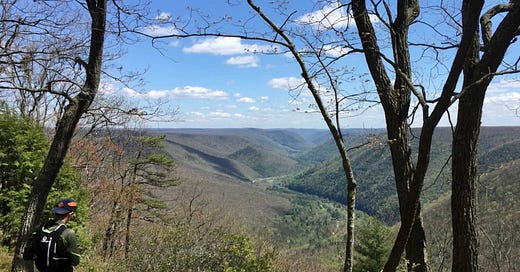Yes, this newsletter is supposed to be about the writing, but other than some lackluster journal entries, the only things I’ve written since the last issue are Eastern States work emails and Slack messages (the race is fast approaching — it’s a busy time).
So instead, I’ll just share some thoughts on one of the best things I came across last week — this pair of old articles about the Western States Endurance Run (Eastern States’ older and better-known western sister) from Joe Uhan on iRunFar.com: The Western States Killing Machine, Part One and Part Two: The Marble In The Groove.
The mystique of Western States and the place of honor it holds in the hearts and minds of ultra runners is similar to that of the Boston Marathon for road runners. It’s the original hundred-mile footrace of the modern era. It’s the most famous hundred, it’s one of the biggest spectacles in our sport, and other than the Ultra-Trail du Mont-Blanc (UTMB), it’s the closest thing we have to an Olympics of ultra running.
Which is why people like me spend years entering the lottery for a chance to run it (I’ve been qualifying and entering each year since 2015, and my odds might be up to 30-40% in this year’s drawing). It’s one of those events you put on your list and build your racing schedule around, just because it’s Western States.

But if you’re an eastern mountain runner, you might also feel some condescension towards Western States, because by most objective measurements it’s just not quite as difficult as some of our hallmark eastern races. It’s trails are smoother, it doesn’t have as much climbing, it’s hot but not so humid… you might feel like it gets more hype and gushing attention than it really deserves.
And I don’t think it’s a secret that the name of our race — “Eastern States 100” — was chosen at least in part to draw the attention of the trailrunning world, as a way of saying “Hey, you know we have some really great trails here in the east, and some really great runners, and a trailrunning community that’s just as vibrant as anything you have out there in your fancy California mountains.”
I’m trying hard to break myself of the need for superlatives, though. “My race is harder than your race” has a juvenile tone that I want to replace with an honest appreciation for the inherent and unique difficulty and beauty of each race I run, of every mountain I visit.
That’s where this pair of articles comes in, and why I like them so much. They give a clear and detailed explanation of why Western States is a worthy challenge, regardless of what other races you’ve run or what your usual trails are like.
They also helped me realize how deep the collective pool of understanding, both tactical and strategic, is for that race. So many people have been running it for so long, and there are so many stories, so many lessons learned.
I think the same kind of stories are beginning to accumulate around our race, and at least the start of some of that same deep understanding of the course and what it takes to excel on it. I think that’s important, because Eastern might be a tougher nut to crack (but there I go again…).
Anyway, watching all of this happen is a joy. As is the fact that both of these races (and hundreds of others) are out there waiting for us, and they’re all good in their own way, all hard in their own way. Learning to appreciate that is an important part of my growth as a runner, and as a person.





